right good
The Only Way to Escape When Piranhas Surround You
Whoosh — waaaa! You’ve just been pushed out of an airplane up high in the skies of Brazil, and there’s nothing but you, your parachute, and the ground far below you. And it’s getting closer by the second. Open, open, you useless backpack! Phew, finally. But you notice you’re now gliding straight...
Oh no, you’re falling down into the Amazon River! There’s nowhere to escape now — splash! You’re in the water, covered by the heavy canvas. You push it aside, struggling for breath and trying to find your bearings. But as soon as you free yourself from the parachute trap, you notice some strange movements underwater.

There’s one dark silhouette circling around you, hey, there’s one more! Two, three, five... there’s a whole school of fish, and they seem to be a little too interested in you. Oh, no. You freeze in horror. Piranhas. All you want to do is scream in fear and get away — but wait.
Piranhas are calm and even a bit shy; they usually won’t go after humans. In fact, it’s like with most animals — they’re afraid of you more than you are afraid of them. Plus, they’re more of scavengers than hunters, so they’re really not that into you.
But if you make any sudden moves, they might panic and want to come and check out what’s going on — with their teeth, of course. Some piranha species are even vegetarian! Don’t get your hopes up too high, though, these surrounding you probably wouldn’t say ‘no’ to some nice human steak... So, yeah, either stay calm or try to move reeeally slowly.
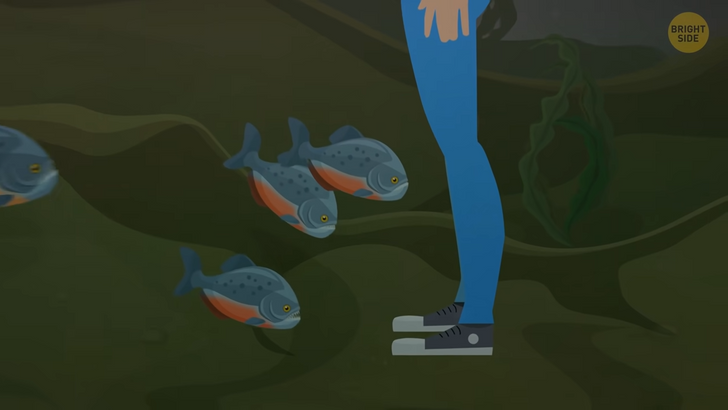
Red-bellied piranhas, the most dangerous species among them all, have very good hearing and react to noise. That’s how they locate their prey — the entire school communicates by sending signals to each other when they find potential prey. Try not to become it by yelling. Red-bellied piranhas not only hunt when they hear noise, but they also produce it themselves. If you pick one up or if it faces another fish, the piranha barks like a dog. Like they aren’t scary enough already!
Don’t throw away your parachute just yet. If there’s anything in your backpack, try to protect your hands and feet. These are vulnerable, easily accessible, and probably quite tasty targets piranhas might go for. Their jaw is strong enough to crush bone, so some solid shoes and thick gloves will come in handy.
Movies often present piranhas as ferocious monsters with a huge set of saws for teeth. No wonder we’re all afraid of them after seeing them ruin all the lake fun during the spring break.
Hollywood actually picked it up from Theodore Roosevelt: at the beginning of the 20th century, he wrote a book where he described piranhas as “the most ferocious fish in the world”. He said he saw a school of these fish deal with an entire cow in a matter of seconds. Well, it might not be entirely like that — research showed this is not quite a typical situation when humans or some bigger animals face piranhas.
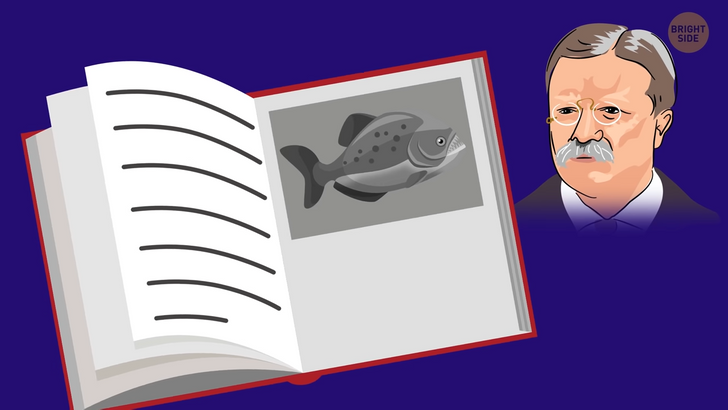
Yes, their razor teeth are really insanely sharp and around ¼ inch [(5 mm)] long. It’s common that marine animals such as sharks and piranhas often lose their teeth; sharks lose them one by one, while piranhas replace them in quarters.
Piranhas have a strong bite and the reason why they can actually take down animals many times their size is that they don’t waste any time chewing. As they snap their jaws and bite down, the food simply goes into their bellies. They rotate, change position all the time, bite their prey, and take turns incredibly fast. So, if you see that boiling-water effect going on — it spells trouble!
Megapiranha, the ancient relative of today’s fish, lived around 10 million years ago and had an insanely strong bite. T-Rex’s bite, for example, was only three times stronger despite being waaay bigger than Megapiranha, which only weighed around 22 pounds.
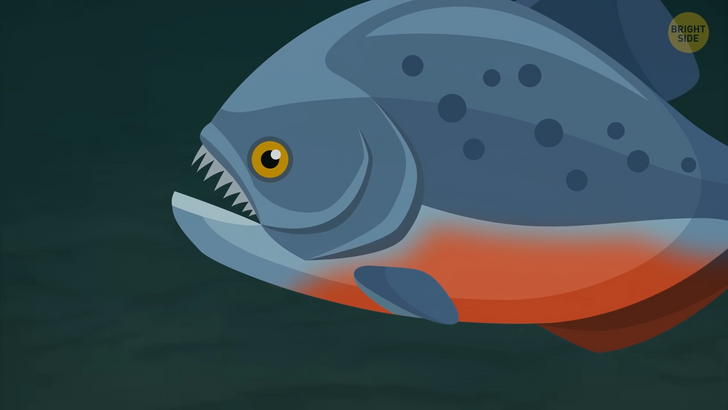
We’re not part of their everyday diet. Piranhas are more likely to go after animal remains or some sick, old animal that can’t even move properly. Hopefully, you’re not close to their eggs, because they won’t hesitate to use their teeth to protect them. That and the situation when they’re literally starving — those are some moments where their attack can be a little bit extreme, like with that cow from Roosevelt’s story.
Still, research says dealing with a bigger animal like that within 5 minutes requires around 500 piranhas, which is definitely a lot more than any recorded wild school. In fact, the common shoal size is often around 20, so they will need a bit more to take you down. Slow-moving, shallow, and warm water is something they prefer to chill and breed, so if you have the chance, try moving to deeper, colder water with stronger and faster currents.
Okay, so you managed to escape piranhas, you’re swimming, the river is taking you far away, and.... Oh no, a fin is heading your way. As if the Amazon River is not scary enough already, now it needs to have sharks too! And it’s not just any shark — we’re talking about the bull shark, one of the most dangerous species, related to tiger and white sharks — plus, it even has the strongest bite of them all. Piranha, who? These guys are in way more movies than them!

Bull sharks can be found in both saltwater and freshwater, and they simply love warm, shallow river-type waters — yes, like where you are at the moment. They don’t rear their young or lay eggs.
Similar to mammals, their pups are born live, which is why they prefer to go for freshwater habitat. They eat turtles, birds, crustaceans, and other fish; those that live in Africa sometimes even attack hippos! They’re not often lucky with those beasts, though.
They’re really not that picky when it comes to food, so I doubt they will refuse a tasty bite swimming towards them. Even though the only thing you want is to catapult yourself as far as possible at that moment, try to stay calm. Maybe a shark is just chilling because it already ate too much, so it’s passing by you without any interest sparkling in its eyes. Move slowly, float, and keep an eye on the shark. Wait for it to swim away from you.
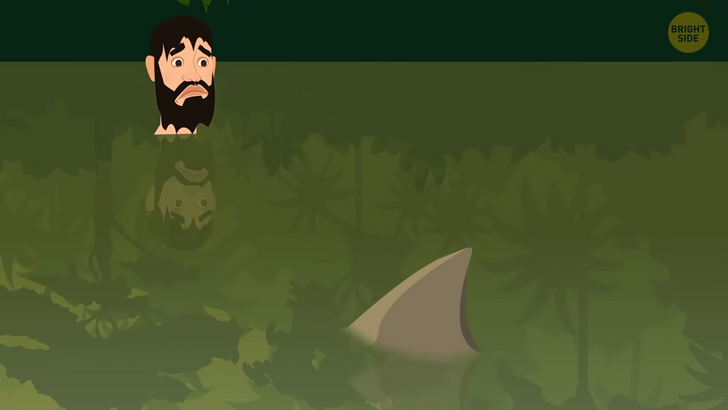
Oh no, maybe the first one doesn’t feel like going after you, but that second one came a little bit too close. Okay, different rules then! These animals prefer easy meals that will swim into their mouth, so they will certainly appreciate it if you don’t defend yourself — which is exactly what you should do! Go for sensitive body parts such as eyes, gills, and nose — especially if you have some sharp objects.
When in shallow water, take a defensive position, and stand firmly on the ground. Show off a little bit with all those moves you used to watch in martial arts movies!
If there are reefs, rocks or some other firm objects around you, back up against them, so the shark can’t surprise you from the back. If you’re in open water, it would be better to have a companion to take a back-to-back position, so you can cover all directions.
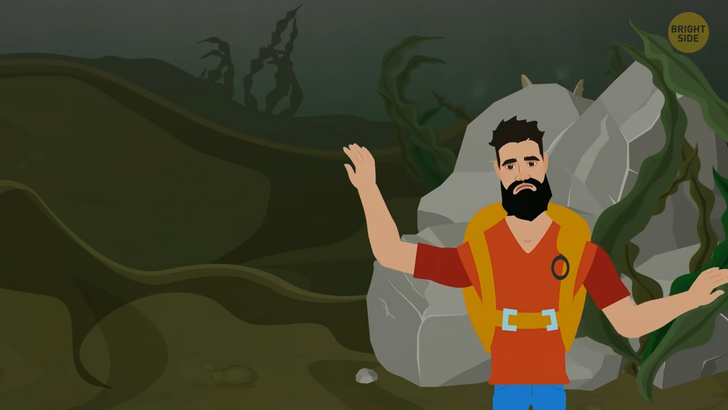
Boom, you got it in the eye! Startled, the shark is leaving, but don’t relax just yet — it will probably return after its eye goes back to normal.
Now it’s time to let out all your panic and swim away as fast as you can to finally leave the water and all those creatures lurking under the surface. You get out to the shore, breathing heavily and try to relax.
Hopefully, it’s over now, haven’t you gone through enough? Oh no, another noise! What is it NOW??
Comments
Related Reads
How 20 Women That Got the “Miss Universe” Title Last Century Looked

14 Stories From Women Who Had an Unexpected Twist in Their Life

15 Stories About People Whose Behavior Breaks All Possible Stereotypes

15+ People Who Made a Last-Minute Decision That Changed Everything

I Overheard My Husband Asking Our Little Son Not to Tell Me What He Saw, the Truth Hit Me Harder Than Infidelity

My Husband’s Ex Wanted to Make Me Homeless and Poor, Karma Hit Her Hard

I Will Not Look After My Stepchild During a Romantic Getaway

I’m Being Thrown Out of My Own House by My DIL

My MIL Made a Scene at My Birthday Party and Got Exactly What She Deserved

I Asked My Son’s Ex-Wife to Join Our Holiday Dinner — It Ended in Disaster

My SIL's Wedding Gift Left Me Humiliated and Crying on the Spot

17 People Who Rented a Place and Got Into Trouble
